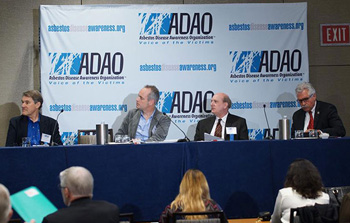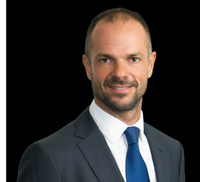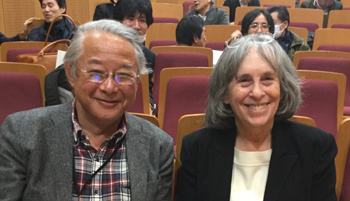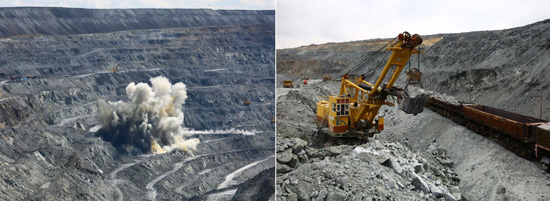

ASBESTOS FRAUD Robert Moore (top and second left above), paid by corporate surveillance group K2 Intelligence to spy on asbestos activists, scammed invitations to campaign events worldwide including two conferences organised by the US Asbestos Disease Advocacy Organisation (ADAO).
With offices in London, New York, Madrid, Geneva and Los Angeles, K2 Intelligence boasts it “is redefining 21st century corporate intelligence by combining deep subject-matter expertise with cutting-edge technology in an unprecedented way.”
But it’s not above a bit of old-fashioned spying.
Which is why, in November 2018, K2 Intelligence found itself paying ‘substantial’ damages to five prominent anti-asbestos campaigners. The confidential settlement came after evidence emerged K2 had orchestrated a covert surveillance operation intended to undermine efforts to ban the deadly fibre.
 The campaigners took their legal case against K2, Matteo Bigazzi, K2’s executive managing director in London (right), and the hired infiltrator, former TV producer Robert Moore. The London high court heard details of ‘Project Spring’, where Moore was paid six figure sums for four years to infiltrate and spy on the campaigners’ anti-asbestos network, including secretly recording phone conversations and meetings.
The campaigners took their legal case against K2, Matteo Bigazzi, K2’s executive managing director in London (right), and the hired infiltrator, former TV producer Robert Moore. The London high court heard details of ‘Project Spring’, where Moore was paid six figure sums for four years to infiltrate and spy on the campaigners’ anti-asbestos network, including secretly recording phone conversations and meetings.
Exposed in court
K2 settled the legal action two years into the court proceedings, by which time the court had already heard the aim of K2’s espionage was to gather information about the campaigners, their methods, funding and future plans. In a document entitled ‘Phase One Report’ presented to the court, Moore told Bigazzi that the best way to infiltrate the group without arousing suspicions would be to present himself as a documentary filmmaker eager to develop a series of films about dangerous industries, not just asbestos.
WHO PAYS? K2’s clients, which the global surveillance firm had tried strenuously to conceal, were revealed on the instruction of the high court to be Wetherby Select Ltd, a holding company in the British Virgin Islands; Kazakh asbestos and employers’ lobbyist Nurlan Omarov; and politically well-placed US fixer Daniel Kunin. [more]
“The advantage of going into this world with a bigger agenda than simply asbestos is that it might make my entry seem less deliberate,” he wrote.
One claimant, London-based Laurie Kazan-Allen, heads the respected International Ban Asbestos Secretariat (IBAS). She is arguably the lynchpin and most influential figure in the global campaign against the cancer-causing fibre. I was also a claimant, along with lawyers Krishnendu Mukherjee and Harminder Bains, and Sugio Furuya, the Japan-based spearhead of Asian Ban Asbestos Network (ABAN).
Cynical and clinical
Moore first approached the five in 2012. As well as claiming to be a documentary filmmaker who wanted to make a film exposing the hazards of asbestos, he said he also wished to create a ‘Stop Asbestos’ charity. He had connections, he told Kazan-Allen, mentioning his sister Charlotte Moore was a top executive at the BBC. This at least was true.
Under his well-crafted cover Moore embedded himself into the heart of the network, and from 2012 to 2016 gained access to highly confidential information. He was thorough.

ASBESTOS HEROES Sugio Furuya of ABAN and Laurie Kazan-Allen of IBAS were top targets of asbestos spook Rob Moore, reflecting the real threat they’ve posed to the deadly industry’s bottom line.
Timesheets submitted to K2 by Moore show that when Kazan-Allen was being treated in hospital after a heart attack, he made a claim for the time spent writing a sympathy letter to her husband. Invoices produced by Moore show that over a two-year period K2 paid him a total of £336,015, topped up with £130,430 in expenses. The project ran for four years.
Less than a year into his asbestos espionage activities, Moore had already recognised the campaigners’ concerns and motives were creditable. He wrote to Bigazzi in late 2012, court papers revealed, that the campaigners “have a good argument on their side.”
Still, Moore continued his undercover charade for a further three years, a quest that took him to meet union activists and asbestos disease victims’ advocates in the USA, Canada, several European countries and, crucially, Asia. Although the health risks associated with exposure to asbestos have been known for decades, and its use has been banned in the UK and EU since 1999, use of chrysotile – or white asbestos – is still permitted in most countries.
The major producers are Russia, China and Kazakhstan. China uses its production internally. Russia and Kazakhstan, though, are big exporters.
Global battle
Included in K2’s strategy was gaining inside knowledge on chrysotile usage in Thailand and Vietnam, part of the asbestos industry’s Asia frontline where it is pursuing a well-resourced promotional drive. Asia is seen by Big Asbestos as a major developing market and key to its survival.
As Krishnendu Mukherjee, a barrister who has worked extensively on asbestos cases in India, noted: “Rob Moore spied on anti-asbestos activists in India and in other Asian countries where the use of this carcinogen is rapidly increasing.”
ABAN coordinator Sugio Furuya added: “The spy shamefully deceived dedicated people working to avoid unnecessary deaths due to asbestos in Asia, the last resort for the international asbestos industry and the main target of the spying operation. However I can confirm, the work is continuing and Asia is moving towards a ban on asbestos.”
This was a central concern of K2’s clients. Over the course of the project, K2’s Bigazzi was asked to provide his clients country-by-country updates from regional ban asbestos conferences. He was also asked to provide intelligence on the campaign’s strategies and ideas on the potential for new national asbestos bans.
But by late 2015, Moore’s cover story was crumbling and K2’s role was about to be exposed. In 2016, another group in K2’s sights, Global Witness, tipped off the asbestos campaigners that Moore was a spook.
Fight to the death
The asbestos five initiated legal proceedings in October 2016 for breach of confidence, misuse of private information and breach of the Data Protection Act. Richard Meeran, a partner at law firm Leigh Day and the solicitor acting for the claimants, said: “The extent of intrusion into these campaigners’ private lives shines a worrying light on the opaque activities of the burgeoning, corporate intelligence industry.”
Laurie Kazan-Allen commented: “The global campaign to ban asbestos is a legitimate grassroots movement backed by untold numbers of asbestos victims, trade unionists, NGOs, legal, medical and technical experts. This case was initiated to expose covert actions to infiltrate our network and target those of us perceived to be a threat to the asbestos industry. We succeeded in our aim in this litigation. The asbestos industry will lose the battle to preserve asbestos markets.”
In the end, it was a costly project for K2 and its backers. In addition to footing millions in court costs, there has been substantial reputational damage.
While court injunctions have limited coverage in the UK, elsewhere it was different. The case has been big news in the US, where it was covered at length by the New York Times. National papers and magazines from Canada to Australia published in depth features exposing the industry’s malfeasance aided by its hired spies.
Not that the industry ignored this international bad press. Australian magazine New Matilda received threatening letters from four separate law firms in the UK and Australia after publishing an indepth feature naming Moore, K2 and it clients. The magazine published the letters online.
Harminder Bains, a partner and asbestos disease specialist at Leigh Day, said: “The strategies and tactics used by Moore have been elicited by this court case. We should not be intimidated, but should continue to campaign and expose the asbestos industry’s lies.”
The campaigners know the asbestos industry will fight back. And corporate spying is just one of the tools in its locker. Research by Hazards has revealed the existence of a cabal of UK-based scientists who are among the asbestos industry’s favourite hired guns, churning out junk science in defence of their wares (Hazards 133).
In recent months they have cropped up in defence of the talc industry, which has been ordered by the courts to make multibillion dollar settlements after its asbestos contaminated product was found to have caused deadly cancers.
Healthy profits at a deadly cost
 K2’s clients, which the global surveillance firm had tried strenuously to conceal, were revealed on the instruction of the high court to be Wetherby Select Ltd, a holding company in the British Virgin Islands; and Kazakh asbestos and employers’ lobbyist Nurlan Omarov. Also named as a client was Daniel Kunin (right), a US national and deal fixer whose mother, Madeleine, has served as a US ambassador and Vermont state governor.
K2’s clients, which the global surveillance firm had tried strenuously to conceal, were revealed on the instruction of the high court to be Wetherby Select Ltd, a holding company in the British Virgin Islands; and Kazakh asbestos and employers’ lobbyist Nurlan Omarov. Also named as a client was Daniel Kunin (right), a US national and deal fixer whose mother, Madeleine, has served as a US ambassador and Vermont state governor.
The clients were politically-well connected and had access to what it became clear was a substantial war chest. But there was scope for a handsome return on a contract believed to be worth in excess of £1m to K2. Even today, asbestos remains a business worth hundreds of millions each year, with potential to grow. By the end of 2018 barely a quarter of countries, 66 in total, had introduced comprehensive asbestos bans.
A richly-resourced public relations campaign has seen asbestos industry lobbyists court governments and new or expanded markets in India, Pakistan, Sri Lanka, Vietnam, Thailand and elsewhere, with some success.
Asbestos spy Robert Moore also targeted top people at the UN’s World Health Organisation (WHO) and its International Agency for Research on Cancer (IARC). WHO has maintained – contrary to frequent claims from asbestos lobbyists, who claim its expensively concocted asbestos ‘safety in use’ approach is supported by the agency – for over a decade that the only sure way to end the asbestos disease pandemic is to stop its use entirely.

And K2 client Nurlan Omarov, has been a visible lobbyist on the international stage for many years. The Kazakh industry lobbyist and representative of the massive Kostanai asbestos mine (above) has been a repeat member of industry delegations that campaigned successfully to keep chrysotile off the UN’s Rotterdam Convention list of the extremely hazardous substances that require a ‘prior informed consent’ process prior to export.
But someone has to pay the price. Latest statistics suggest that global asbestos mortality could now exceed 300,000 deaths each year. These aren’t ‘good’ deaths. Asbestos deaths are frequently slow and cruel, bodies wracked with pain, choked and suffocated. They are the true cost of asbestos.
Back to main story • Top of the page
I spy
It is the world’s most prolific workplace killer. But asbestos is still big business. Which is why a corporate intelligence multinational was commissioned by the asbestos industry to spy on its opponents. Hazards editor Rory O’Neill, one of five industry critics who took legal action after being targeted by the spooks, explains.

| Contents | |
| • | Introduction |
| • | Exposed in court |
| • | Cynical and clinical |
| • | Global battle |
| • | Fight to the death |
| Related stories | |
| • | Healthy profits at a deadly cost |
| Hazards webpages | |
| • | Asbestos |
| • | Cancer |

